You’ve probably already seen the numbers. Like these compiled by dropshipping platform Oberlo:
- Expect a return of $42, on average, for every $1 you spend on email marketing. (Direct Marketing Association, 2019)
- The majority of small to midsize businesses, 81%, primarily use email to acquire customers, while 80% use it to retain them. (Emarsys, 2018)
- Videos in email can boost click rates by an astonishing 300%. (Martech Advisor, 2017)
In other words, despite the many modes of communication businesses can now use to reach their customers, email still works wonders.
So, if you’re looking for email marketing tips and tricks to incorporate into your processes, we’ve got you covered.
At a glance: Email marketing tips your business should try:
- Use email marketing software
- Build your email list
- Segment your email list
- Write captivating subject lines
- Maintain a consistent sending schedule
- Avoid the spam filter
- Personalize your emails
Our favorite email marketing tips for small businesses to try
Digital marketing is ever-evolving, which means there’s a lot to learn and improve on. But if you’re an email marketer with not enough time on your hands, keeping up can be a challenge. To help you with that, we’ve done our research and compiled several email marketing best practices you can start implementing today.
1. Use email marketing software
Email marketing is a real challenge without email marketing software. It may be okay to skip email automation in the beginning, when you only have a handful of subscribers, but as time goes on and you grow your subscriber list, you’ll need it to keep everyday, repetitive tasks off your plate.
As such, it’s best to choose one right out of the gate.
The best email marketing software options allow marketers to automate essential B2C and B2B email marketing tasks such as capturing email addresses, adding subscribers to a list, sending autoresponders, and generating marketing analytics reports, to name just a few.
How to use email marketing software
Your email marketing software is vital for creating successful email campaigns. Used properly, it can assist with a host of things. With it, you can:
- Save and organize your contacts: All of your email contacts and subscribers are saved in one place, segmented according to the various list parameters you put in place.
- Use customizable email templates: Most email marketing software systems come with WYSIWYG (what you see is what you get) editors and professional-looking templates you can use out of the box. Others let you create templates from scratch and save them for later use.
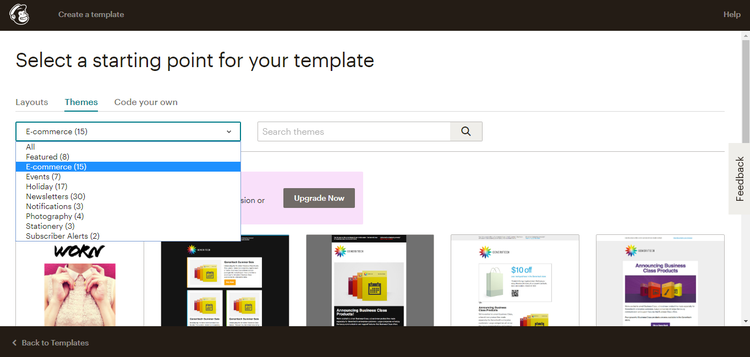
Mailchimp offers customizable email templates available even with the free plan. Image source: Author
- Create campaign landing pages: With landing pages, you can keep emails short by simply adding links to pages that offer more information. You can even add a buy button to get subscribers to purchase the product or service you’re promoting. GetResponse and Sendinblue are just two of the email software options that offer landing page creation capabilities with their drag-and-drop page builders.
2. Build your email list
Depending on your marketing objectives, there are different marketing techniques you can tap to get the word out about your product or service. However, there’s a downside to using platforms you don’t own.
Like in the case of social media marketing, if you violate the rules of a social network, even inadvertently, you can get kicked off the platform -- sometimes without notice. As a result, you lose your page, your followers, and the data you’ve generated from previous campaigns.
When you build a list for email marketing, you own the list, and you can use it, again and again, to communicate with your subscribers.
How to build your email list
How do you get started building an email list, if you haven’t already? Here are some email marketing tricks for list building:
- Create gated content: Also referred to as lead magnets, gated content can be downloadable assets, such as an ebook or white paper, or upgrades to the content a reader is currently consuming, such as a checklist or free template, that they can get for free in exchange for their contact information or email address.
- Allow website users to opt in: Give visitors the option to subscribe to your email list. Leverage website analytics for successful email marketing to determine which pages get the most views, then add an email sign-up form on those pages and other high-converting places on your website (e.g., your “about” page, footer, sidebar, floating bar, blog posts, resource pages, etc.).
- Leverage social proof: Social proof is rooted in the belief that there is power in numbers, and that an individual’s decision can be influenced by the majority’s decision.
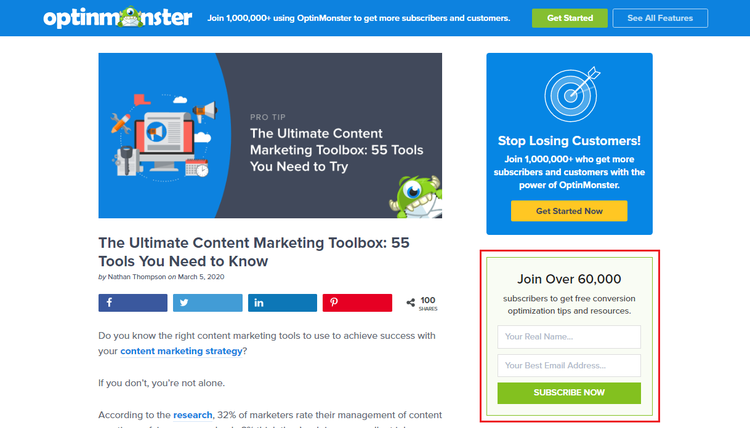
OptinMonster uses social proof to entice readers to subscribe to its mailing list. It’s hoping the fact that it has already amassed 60,000+ subscribers might convince you to give them your email address, too. Image source: Author
- Include a sign-up link in your emails: Take full advantage of every email you send by always adding a link to your company’s sign-up form or website landing page.
3. Segment your email list
When it comes to building your email list, personalization (more on this later) is one of the best small business email marketing techniques you can employ. Your subscribers are not just numbers or names on a list. They’re real people with unique needs who expect to be treated as such by the brands they choose to trust.
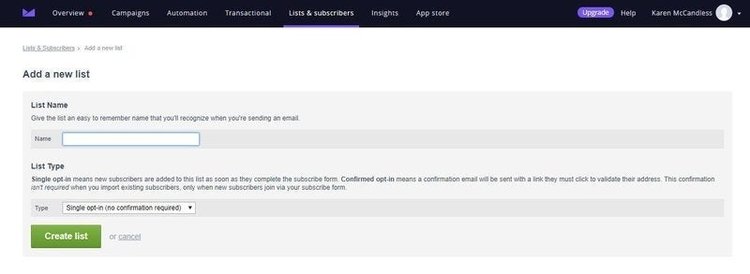
Email marketing software Campaign Monitor allows you to create and manage subscriber lists. Image source: Author
This is why you have to properly segment your email lists. You want to send content that resonates with your subscribers or answers their most pressing questions -- content they signed up for and are happy to receive, essentially.
How to segment your lists:
Market segmentation means you divide a large list of subscribers into different groups based on certain characteristics. There are four ways to segment your lists:
- Demographic segmentation: This segmentation method uses variables such as age, gender, religion, income, educational attainment, nationality, race, and ethnicity.
- Geographic segmentation: Segment your list by area or location, such as city, county, state, country, or continent. Geographic segments can also be broken down into urban or rural regions.
- Behavioral segmentation: This technique uses customer behavioral data -- meaning, how customers interact with your business. Examples include buying patterns, the benefits customers are looking for in your product or service, how frequently they use it, and their position in the customer journey.
- Psychographic segmentation: This method splits your list according to customers’ beliefs, personality traits, attitudes, values, lifestyles, and interests. If you’re an online smartphone retailer, for example, you can segment your e-commerce email marketing list according to smartphone types, such as iPhone or Android. You can further break down the Android group into the different Android phone brands.
4. Write captivating subject lines
We’ve been told again and again not to judge a book by its cover, but the reality is, most of us do. The same can be said about sales email marketing and other forms of email marketing -- people judge the subject lines (in other words, the covers) of your emails.
Given that, the key to getting your emails opened is a subject line that stands out in a packed inbox, especially since the number of emails sent and received around the world per day averages in the hundreds of billions.
How to make your subject lines captivating:
Your email subject line is similar to your article or blog post headline, which advertising legend David Ogilvy calls the “ticket on the meat.”
Best practices for subject line copywriting include using action words and a length of 6-10 words. Here’s a subject line cheat sheet from Constant Contact you might find helpful. Once you have those down pat, consider the following email marketing campaign tips for subject lines, too:
- Create a curiosity gap: Between what we already know and what we still need or want to know is a space called the curiosity gap. Use it to your advantage. In other words, pique your readers’ interest with your subject line to get them to click.
- A/B test your subject lines: Any list of effective email marketing tips won’t be complete without testing, testing, and more testing. When you A/B test your subject lines, you send two different versions to two different sub-groups of your contacts with the goal of learning which fares better in terms of open rates. Then, you can send the rest of your subscribers the email with the winning subject line.
- Nail your preview text: Although it’s not exactly a part of the subject line (and it can be hidden or displayed depending on your preference in most email clients), the preview text -- sometimes referred to as the preheader text -- is a snippet of text that shows up next to an email’s subject line when viewed from the inbox.
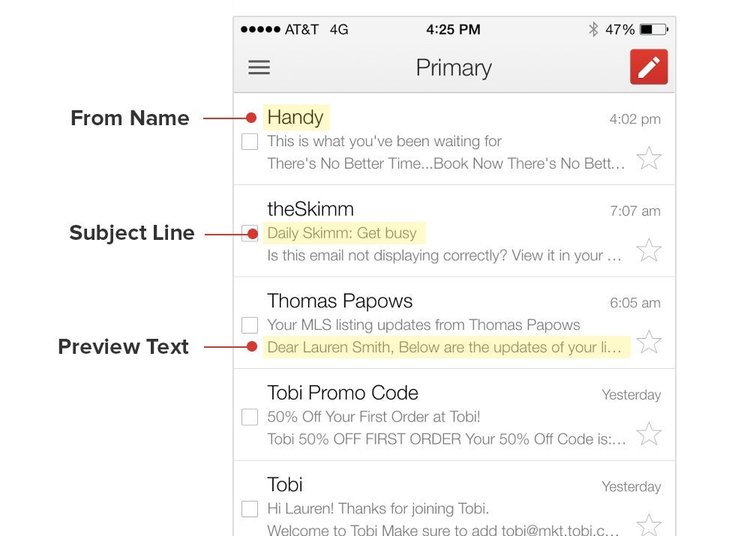
Here’s what preview text looks like on mobile. Image source: Author
5. Maintain a consistent sending schedule
Someone joins your email list because they want to hear from you. If you consistently send them helpful content, they will come to expect -- and even look forward to -- your emails.
How to keep an email marketing schedule:
Email marketing is a process, not a one-time event. Because it’s a process, consistency is key to achieving satisfactory results.
- Create an email marketing calendar: A marketing calendar lets you plan and execute your marketing campaigns more efficiently. It shows you which campaigns are coming up so you can better allocate resources and distribute responsibilities.
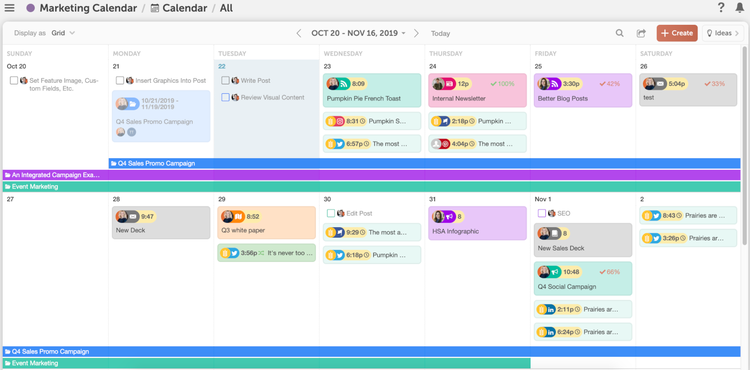
Here’s an example marketing calendar from CoSchedule, where you can also schedule your email newsletters and campaigns. Image source: Author
- Identify the best days and times for sending emails: Most research studies suggest that midweek -- Tuesdays, Wednesdays, and Thursdays -- are the best days to send an email, while 10 a.m., 8 p.m., 2 p.m., and 6 a.m. are the best times. You may have to conduct your own testing to determine the best days and times for your specific audience.
6. Avoid the spam filter
Within email marketing, there are several digital marketing terms you’ll hear a lot. One of them is spam filtering. Spam or email filters prevent unwanted or malware-infested emails from reaching recipients’ inboxes.
Internet and email service providers use them on both inbound and outbound emails to protect their customers.
How to keep your emails from the spam folder:
Although spam filters are generally a good thing, the problem is that messages from email marketers with no ill intention sometimes get filtered, which can cause reputational damage and email deliverability difficulties that can be hard to reverse.
To avoid spam filters, consider the following email advertising tips:
- Avoid spammy subject lines: Subject lines in all caps or with too many exclamation points -- these are just two of the indicators that an email might be spam.
- Add instructions to whitelist your email address: Add a message that asks subscribers to add you to their safe senders list, with a link to a post, page, or video that walks them through the process.
- Make sure you have the subscriber’s permission: Think long and hard if you plan to buy ready-made lists, and use double opt-in (in which you ask subscribers to confirm their subscriptions prior to adding them to your list) to ensure people actually want to receive your campaigns and messages.
- Follow email regulations: Become familiar with the anti-spam laws governing your country or state. Email service providers also have their own anti-spam policies users must adhere to.
- Keep your lists updated: Your lists need regular spring cleaning. Remove email addresses that are no longer valid, and unsubscribe or re-engage inactive subscribers.
- Make unsubscribing as easy as subscribing: Don’t give people the runaround when they’re trying to unsubscribe. Each email you send should include an unsubscribe link or a button that’s easy to find.
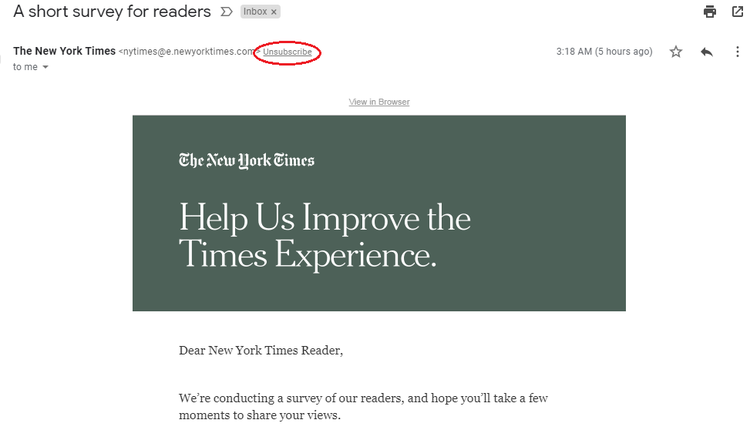
The NYT’s unsubscribe link is right there at the top, next to the “from” name. Image source: Author
7. Personalize your emails
One surefire way to make subscribers feel they matter is by sending them relevant, personalized emails. The more they feel you’re paying attention, the more they’re likely to pay attention to your brand.
How to personalize your emails:
Email personalization goes beyond just using the subscriber’s name in the salutation or subject line. It also means crafting individualized emails that show recipients they matter to you and that you understand what they want or need.
Aside from email segmentation, discussed above, here are a few more email personalization techniques:
- Send behavior-triggered emails: Behavioral or triggered emails are emails sent in response to a customer’s behavior or action. Examples are a welcome email right after a subscriber signs up, or a confirmation email to assure customers that their package is on the way.
- Include a personalized video: Personalized videos in emails include elements unique to the recipient, such as their name, image, company name, job title, logo, etc. However, this doesn’t mean creating an original video for each subscriber. Instead, leverage the power of video personalization platforms so you can use the same video repeatedly while personalizing certain elements.
- Send anniversary emails: Include discount coupons or gifts when you send your subscribers an anniversary or birthday email.
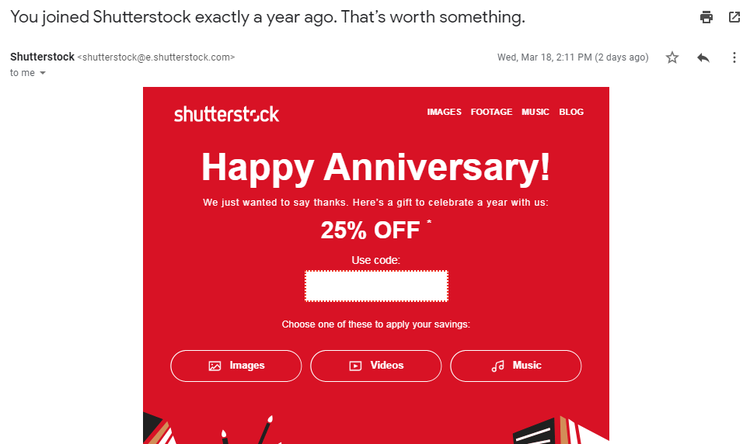
The recipient’s name in a salutation would have personalized the email even more, but here’s one way to make use of anniversary emails. Image source: Author
Drive conversions with email marketing
Email is here to stay, which means email marketing is still one of the best ways to reach out to your leads and customers. It’s cost-effective, personal, and, done right, can build your brand, increase sales, and turn customers into brand advocates.
If you need more proof that it actually works, here are some more email marketing examples to explore.
Our Small Business Expert
We're firm believers in the Golden Rule, which is why editorial opinions are ours alone and have not been previously reviewed, approved, or endorsed by included advertisers. The Ascent does not cover all offers on the market. Editorial content from The Ascent is separate from The Motley Fool editorial content and is created by a different analyst team.